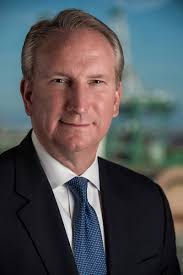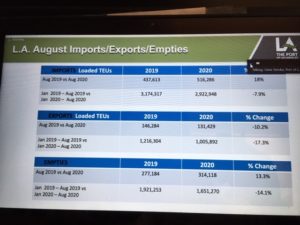BY STAS MARGARONIS
At a September 15th virtual press conference, Port of Los Angeles executive director Gene Seroka announced that imports rose in August and the Port sees trends indicating volumes will continue to improve in September and October.
Seroka says he is “hopeful” about the rest of the year, despite the downturn related to the Covid pandemic. Consumers have saved money that they would have been spending travelling and going out to restaurants. The result is consumers are accumulating more disposable income.
National Retail Federation Vice President Jonathan Gold joined Seroka at the press conference and agreed that there was reason for guarded optimism for improvements in retail spending for the rest of 2020.
Gold also welcomed the September 15th World Trade Organization finding that the U.S. broke global regulations when the Trump administration imposed $400 billion in tariffs on Chinese exports to the United States. Gold called the tariffs “taxes on American business.”
Seroka reported that August imports in terms of loaded twenty-foot unit containers (teus) were up 516,286 teus compared to 437, 613 teus for August 2019.
However, imports for the year to date in 2020 are at 2,922,948 teus compared to 2019 when year to date imports were 3,174,317 reflecting a decline of 7.9% in 2020.
Loaded exports were 131,429 teus in August 2020 compared to 146,284 in August, 2019.
Exports for the year to date in 2020 are 1,005,892 teus compared to 1,216,304 teus in 2019 resulting in a decline in 2020 of 17.3%
Seroka said that the widening gap between imports and exports is creating an imbalance and causing shortages of chassis and containers and impacting rail service.
He put particular emphasis on the fact that “there are 18,000 chassis sitting at marine terminals” at the Port that would be better deployed at a near dock chassis terminal and added “the time for action” moving those chassis into the near dock facility “is now.”
This imbalance is also complicating the ability of the two railroads serving the Port – the Union Pacific and Burlington Northern Santa Fe – to operate more round-trip train services between California to Midwest destinations. The imbalances undermine profitability.
The challenge, he said, for the railroads is a “balancing act.”
During questions from reporters, Seroka was again asked about the letter sent to the California Legislature by maritime stakeholders stating that the high cost of doing business in California is resulting in a loss of market share to U.S. East and Gulf coast ports and citing costs associated with environmental mandates. Seroka has said that there will be no retreat on clean truck and clean equipment initiatives.
Seroka noted that in recent years U.S. East and Gulf coast ports have received $10 billion in federal dollars for infrastructure upgrades compared to $1 billion for U.S. West Coast ports.
In May, Seroka told the American Journal of Transportation that he is working with a coalition to bring cargo back to West Coast ports:
“I’ve put together a coalition of West Coast business interests to bring cargo back to the West Coast and make us the gateway of choice. These include the four major ports (LA, Long Beach, Oakland, Northwest Alliance), the ILWU (International Longshore and Warehouse Union) at both the international and the local level, the PMA (Pacific Maritime Association), the two Western railroads (UP and BNSF) and the PMSA (Pacific Merchant Shipping Association). And our goal here is threefold:
- Attack the operational questions that exist
- The financial questions that persist
- The political regulatory arena that we find ourselves in today. We can’t continue to tax our way out of this.”
Both Seroka and Mario Cordero, executive director, Port of Long Beach have also cited the imbalance of Harbor Maintenance funding where California ports have not received their fair share of funding compared U.S. East and Gulf coast ports.
Recent changes are redressing some of these imbalances, Cordero has said.


